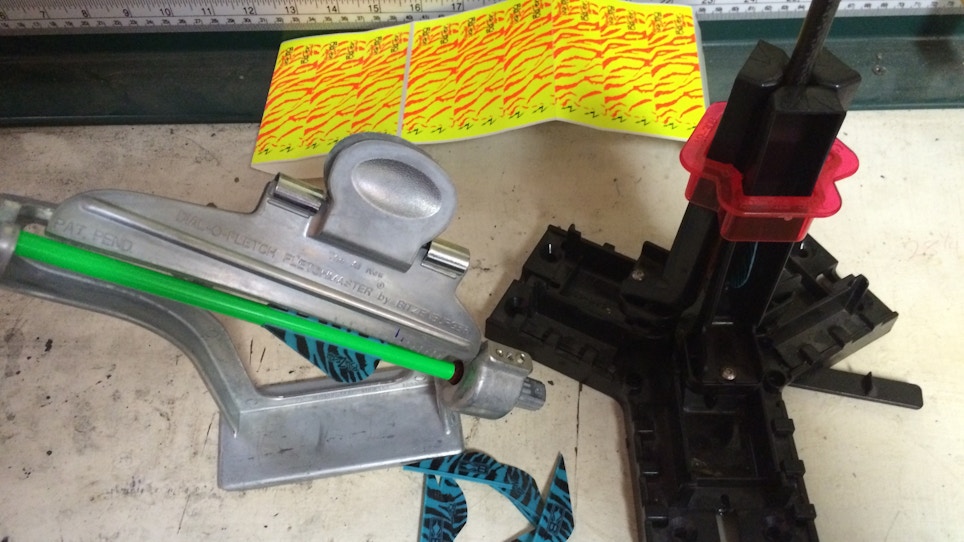Sadly, fletching gets the “glory” shaft when it comes to necessary and essential archery products. Fancy sights, rests, broadheads and arrows steal the show. Sure, these products are necessary and important, but screw a fixed-blade broadhead on a bare shaft, fire it from a bow that’s even minutely out of tune and see what happens. Let me save you the suspense, you won’t like the results!
The steering wheel of your arrow, fletching deserves a bit more praise than we often give it. Today’s fletching offerings are raising the bar in accuracy and are offered in a myriad of sizes, shapes and colors, adding a little flair and excitement to this overlooked accessory category.
Take Bohning’s Blazer Vane for example. This 2-inch, 6-grain fletching staple is offered in more color combinations than I can count and is fully capable of steering mechanical and fixed-blade heads with deadly accuracy. Then there’s AAE’s Max Hunter, a high-profile 2.1-inch, 7.4-grain vane. Offered in packs of 40 and 100, this beauty has resulted in throngs of double-lung hits. Of course, even for compound shooters, feathers have by no means gone by the wayside. In fact, Gateway’s 2-inch Rayzr Feathers promise whisper-quiet flight and spot-on accuracy. Yes, finding a good fletch to steer your arrows isn’t a problem; however, knowing what type of fletch orientation is best for your setup is a tad trickier. Here’s a little guide to help you decide what’s best for your bow-and-arrow combo.
Straight Fletch
This type of fletch orientation is ideal for shooters looking to achieve maximum speed and reduce overall wind drift. Another benefit of the straight fletch is the fact that the vanes, due to their straight-down-the-shaft alignment, are easy to tune with a drop-away-style rest. Regardless of your particular bow’s speed rating, straight fletches rarely create rest-contact issues (unless your rig is severely out of tune). This type of fletch orientation is best suited for those shooting field points and mechanical broadheads. Can you shoot a fixed-blade head with a trio of straight-fletched vanes? Sure, but in my opinion, after years of testing, your downrange accuracy will suffer greatly.
Offset Fletch
An offset fletch is often used by bowhunters looking to increase broadhead stabilization while still maintaining respectable arrow speed. This type of fletch orientation is a favorite of western hunters who shoot at long distances and thread fixed-blade heads into their shafts. The offset fletch promises improved downrange accuracy and minimal rest-contact issues. The only real downside to this type of fletch orientation is reduced arrow speed and possibly a little extra tuning effort.
Helical Fletch
Last but not least is my personal favorite, the helical fletch. You can, with the proper clamp or arm depending on your jig, create a left- or right-helical fletch. The purpose of a helical fletch orientation is to create arrow spin. Much like a bullet coming out of a gun, rotation acts like a gyroscope to quickly and efficiently stabilize the arrow. This rotation will also shield your accuracy from any minute arrow imperfections. If you want an example, perform the following test. First, build a straight-fletch arrow, an offset arrow and a left- or right-helical arrow. Dull the point on the end of each and toss each arrow up and out with your throwing arm. You will notice the straight fletch will spin very little, the offset will spin a little more and the helical will spin rapidly. Again, this spin aids in arrow stabilization and really helps shooters looking for downrange accuracy with fixed-blade heads. Personally, I shoot all of my arrows — those with field points, mechanicals and fixed-blade heads — with this type of fletch orientation. Yes, I lose a little speed and often have to spend a little more time at the bow press and paper tuner to deal with rest-contact issues, but I will take dead-nuts accuracy over speed any day. If I have to sacrifice a few feet per second to ensure the lungs of my next archery victim have a three-blade hole in them, I’m happy to do so.
The bottom line is this: Choosing the right fletch orientation is a matter of personal preference and testing. The aforementioned info is simply a guide to point you in the right direction and give you some options to explore. I have buddies who swear by their straight-fletch arrows and even more who go with the offset. My recommendation to each of you is do some testing. Purchase a jig like the Bitzenburger Dial-O-Fletch. This unit is an all-metal, self-supporting fletch tool that will accept shafts of any diameter and gives you the ability to fletch straight, offset and right- and left-helical. All you need to do is purchase different clamps (average price is $40 per clamp) to experiment with different fletch orientations. This might sound a tad costly, but when can you really put a price on confidence and accuracy?
How did your fletch tests go? What brand and size of fletch are you using? How is that brand working for you? Are you using a straight, offset or helical fletch? Are you using a different fletch orientation for different setups? I want to hear from you. Drop me a line at jbauserman@grandviewmedia.com.






